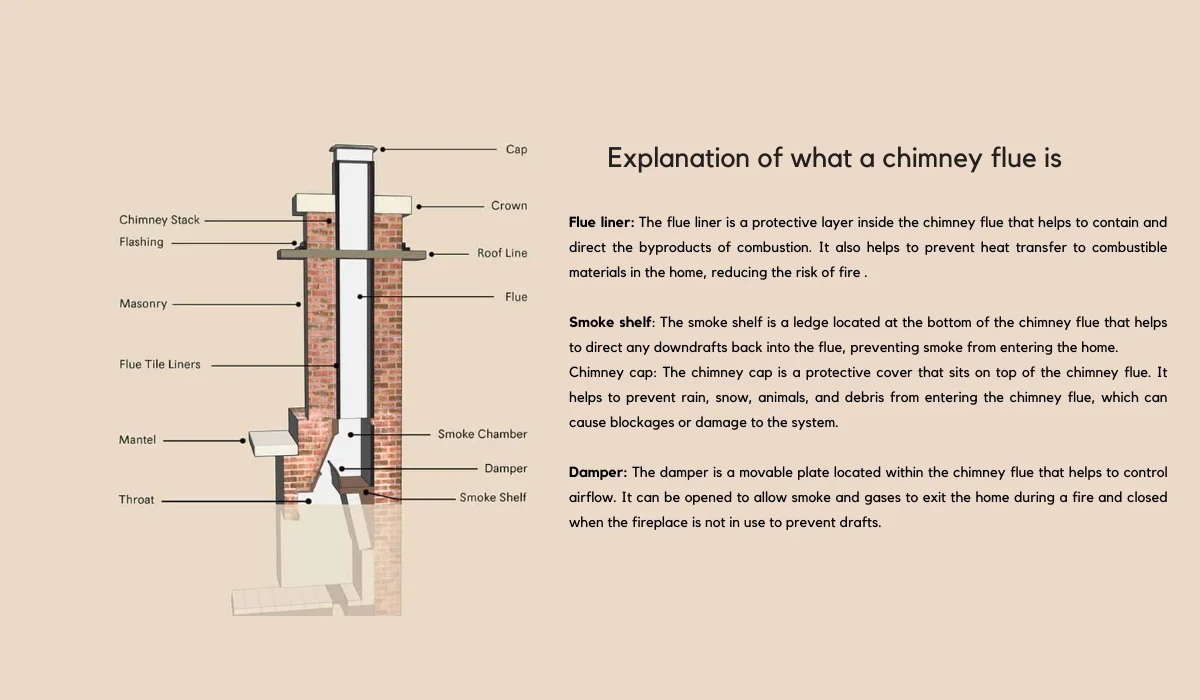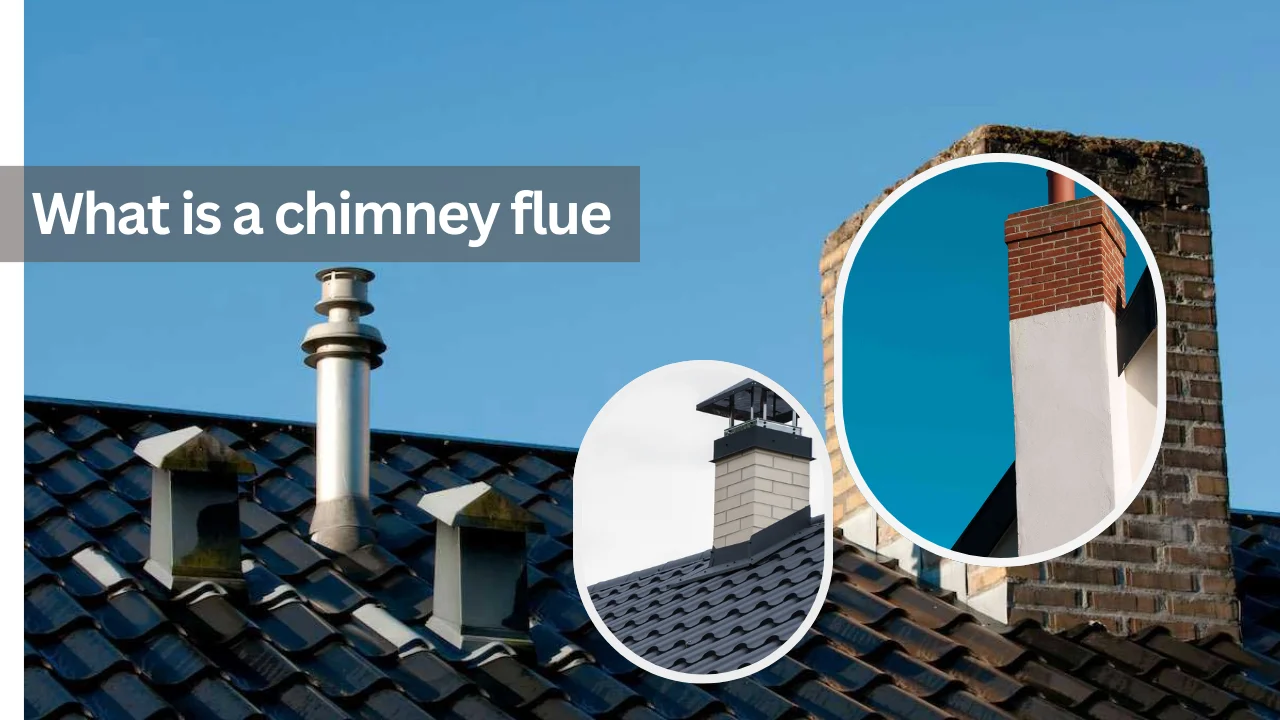A chimney flue is an important part of a chimney system that ensures the safe removal of smoke and gases from a fireplace or heating appliance. It is typically made of metal, clay, or concrete and runs vertically through the interior of the chimney. The primary function of the chimney flue is to create a passage for the byproducts of combustion to exit the home without causing harm to inhabitants.
Chimney flues come in various shapes and sizes, depending on the type of heating appliance being used. They can be round, square, rectangular, or oval in shape. The size of the flue is determined by the size and output of the fireplace or heating appliance it serves.
In masonry chimneys, the chimney flue is typically made of clay tiles or metal liners that are installed within the chimney structure. These materials provide a smooth, non-combustible surface for the byproducts of combustion to travel through safely. The flue liner also helps to protect the masonry chimney walls from heat and corrosion, extending the life of the chimney system.
Explanation of what a chimney flue is
 A chimney flue acts as a passageway for smoke and gases to safely exit the home. It helps to prevent these harmful byproducts from entering the living space, reducing the risk of carbon monoxide poisoning and other health hazards. The chimney flue also helps to create proper airflow for efficient combustion and prevents backdrafts that can cause fires or damage to the heating appliance.
A chimney flue acts as a passageway for smoke and gases to safely exit the home. It helps to prevent these harmful byproducts from entering the living space, reducing the risk of carbon monoxide poisoning and other health hazards. The chimney flue also helps to create proper airflow for efficient combustion and prevents backdrafts that can cause fires or damage to the heating appliance.
Chimney flues also play a crucial role in maintaining the overall efficiency of a chimney system. By providing a clear pathway for smoke and gases to escape, they help to prevent the buildup of creosote and other combustible materials that can lead to chimney fires. Routine cleaning and maintenance of the chimney flue are important to ensure that it continues to function properly and safely.
Purpose of the chimney flue in a chimney system
The primary purpose of the chimney flue in a chimney system is to safely remove combustion byproducts from the home. When a fire is burning in a fireplace or heating appliance, it produces smoke, gases, and other harmful substances that need to be vented outside. The chimney flue provides a clear pathway for these byproducts to exit the home, preventing them from accumulating indoors and posing a health hazard.
In addition to removing smoke and gases, the chimney flue also helps to regulate airflow within the chimney system. Proper airflow is essential for efficient combustion and prevents backdrafts that can cause fires or damage to the heating appliance. The chimney flue acts as a draft inducer, creating a natural flow of air that carries smoke and gases out of the home.
Components of a Chimney Flue
 The chimney flue is made up of several components that work together to ensure the safe and efficient operation of the chimney system. These components include:
The chimney flue is made up of several components that work together to ensure the safe and efficient operation of the chimney system. These components include:
- Flue liner: The flue liner is a protective layer inside the chimney flue that helps to contain and direct the byproducts of combustion. It also helps to prevent heat transfer to combustible materials in the home, reducing the risk of fire .
- Smoke shelf: The smoke shelf is a ledge located at the bottom of the chimney flue that helps to direct any downdrafts back into the flue, preventing smoke from entering the home.
- Chimney cap: The chimney cap is a protective cover that sits on top of the chimney flue. It helps to prevent rain, snow, animals, and debris from entering the chimney flue, which can cause blockages or damage to the system.
- Damper: The damper is a movable plate located within the chimney flue that helps to control airflow. It can be opened to allow smoke and gases to exit the home during a fire and closed when the fireplace is not in use to prevent drafts.
Importance of chimney flues in maintaining chimney efficiency and safety
The chimney flue is vital for maintaining the efficiency and safety of a chimney system, preventing backdrafts, fires, and heating appliance damage.
- Removal of combustion byproducts: The primary function of the chimney flue is to safely remove combustion byproducts, such as smoke, gases, and particles, from the home. If these byproducts are not properly vented through the chimney flue, they can build up in the home and pose a health hazard to occupants. A clean and unobstructed chimney flue ensures that these byproducts are safely directed outside.
- Regulation of airflow: The chimney flue also helps to regulate airflow within the chimney system. By controlling the amount of air entering and exiting the chimney, the flue helps to maintain proper combustion and prevent backdrafts. This ensures that the heating appliance operates efficiently and safely.
- Protection against blockages: Chimney cap, smoke shelf, and damper all help to prevent blockages within the chimney flue. Blockages can restrict airflow, increase the risk of fires, and cause smoke to back up into the home. By keeping these components clean and in good condition, the chimney flue can function properly and prevent blockages that could compromise safety.
- Prevention of heat damage: The flue liner helps to protect the masonry chimney walls from heat and corrosion. Without a proper liner, the intense heat from combustion could cause the masonry to deteriorate, leading to cracks, leaks, and structural damage. By providing a smooth, non-combustible surface for combustion byproducts to travel through, the flue liner helps to protect the chimney structure and extend its lifespan.
List the specific code regulations for chimney flues, including sizing, material temperature resistance, and structural integrity requirements.
In order to ensure proper function and safety, chimney flues must adhere to specific code regulations set forth by various organizations such as the National Fire Protection Association (NFPA) and the International Residential Code (IRC).
One important aspect of chimney flue regulations is sizing. The size of a chimney flue is typically determined based on the type of fuel being burned and the size of the fireplace or appliance it serves. For example, a wood-burning fireplace may require a larger flue than a gas fireplace. It is important for the flue to be properly sized in order to effectively vent combustion gases and prevent buildup of dangerous creosote.
Summary
A chimney flue is a passageway within a chimney that allows smoke, gases, and other byproducts of combustion to safely exit a building. It is typically made of metal, clay, or concrete and plays a crucial role in maintaining proper ventilation and preventing the buildup of dangerous fumes inside a home. Chimney flues need to be properly maintained and cleaned regularly to ensure they function effectively and safely. They also help to regulate the draft of a fireplace or wood-burning stove, allowing for efficient combustion and heat distribution. Proper installation and maintenance of a chimney flue are essential for the overall safety and functionality of a chimney system.
One important aspect of a chimney flue is its size and design, which can impact the efficiency of the chimney system. The size of the flue must be appropriate for the type of fuel being burned, as well as the size and height of the chimney itself. A properly sized flue will help to ensure that smoke and gases are efficiently carried away from the fireplace or stove, reducing the risk of chimney fires and carbon monoxide buildup. The design of the flue, including its shape and construction materials, can also affect how well it functions.


